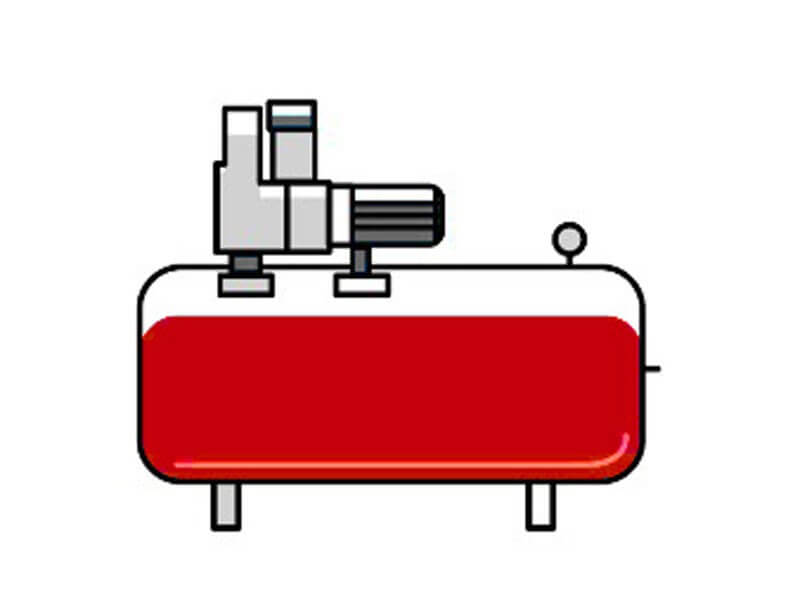Proportioning the Compressed Air Dryer
Trying to figure out which air dryer capacity is best for you? Here are some factors to consider. Read More…
Whenever most people think about a compressor, they probably have a piston compressor in mind. You might already know there are two basic principles of air compression. One of those is the principle of displacement compression. There are a lot of compressor types that classify as a displacement compressor. The piston compressor is one of them, oil-lubricated or oil-free.
The piston compressor is the oldest and most common of all industrial compressors. It is available in single-acting or double-acting, oil-lubricated or oil-free variants, with various numbers of cylinders in different configurations. With the exception of very small compressors having vertical cylinders, the V-configuration is the most common for small compressors. On double-acting, large compressors the L-configuration with a vertical low pressure cylinder and horizontal high pressure cylinder offers immense benefits and has become the most common design.
normally work with splash lubrication or pressure lubrication. Most compressors have self-acting valves. A self-acting valve opens
and closes through the effect of pressure differences on both sides of the valve disk.
Oil-free piston compressors have piston rings made of PTFE or carbon, and alternatively, the piston and cylinder wall can be profiled (toothed) as on labyrinth compressors. Larger machines are equipped with a crosshead and seals on the gudgeon pins, and a ventilated intermediate piece to prevent oil from being transferred from the crankcase and into the compression chamber. Smaller compressors often have a crankcase with bearings that are permanently sealed.
Air compression is essentially a twofold process in which the pressure of air rises while the volume drops. In most cases, compression is accomplished with reciprocating piston technology, which makes up the vast majority of compressors on the market.
Every compressor with a reciprocating piston has the following parts:
Air compressors, for the most part, are powered by either gas or electric motors — it varies by model. At one end of the cylinder are the inlet and discharge valves. Shaped like metal flaps, the two valves appear at opposite sides of the cylinder’s top end. The inlet sucks air in for the piston to compress. The compressed air is then released through the discharge valve.
In certain air compressor models, the pressure is produced with rotating impellers. However, the models that are typically used by mechanics, construction workers and crafts people tend to run on positive displacement, in which air is compressed within compartments that reduce its space. Even though some of the smallest air compressors consist of merely a motor and pump, the vast majority have air tanks. The purpose of the air tank is to store amounts of air within specified ranges of pressure until it’s needed to perform work. In turn, the compressed air is used to power the pneumatic tools connected to the unit supply lines. While all of this is going on, the motor repeatedly starts and stops to keep the pressure at a desired consistency.
What the piston effectively does with its back and forth movements is create a vacuum. As the piston retracts, the space in front gets filled with air, which is sucked through the inlets from the outside. When the piston extends, that same air is compressed and therefore given the strength to push through the discharge valve — simultaneously holding the inlet shut — and into the tank. As more air is sent into the tank, the pressure gains intensity.

Ash Air has been around in New Zealand since 1979, and we’ve grown into a nationwide company with international support and a reputation for quality and reliability.We look after all things compressed air for your business!
Ash Air's range of Chicago Pneumatic, Alup, Pneumatech, and Quincy compressors are used extensively around the world in industries ranging from oil and gas to food, automotive and farming, and we bring you these world class compressors here in the land of the long white cloud.Our technicians are compressed air equipment experts and are dedicated to addressing customer needs. Supported by a 13 locations nationwide, Ash Air offers one of the widest selections of compressed air equipment and parts available today in New Zealand.
With Ash Air compressors, you can count on reliability and high performance for even the most demanding applications. We focus our efforts on the following:
Proportioning the Compressed Air Dryer
Trying to figure out which air dryer capacity is best for you? Here are some factors to consider. Read More…
Maintenance budget: 8 factors to consider
Just like any other equipment, a compressed air installation also requires the necessary maintenance work during its entire lifespan. Even though maintenance costs are only about 5 to 10% of a machine's annual operating costs, failure to budget for maintenance can have potentially disastrous consequences. Read More…
The air dyer is one of the most ignored cooler in the system. A dirty condenser will cause water in the lines, or worse it will cause complete dryer failure. Read More…